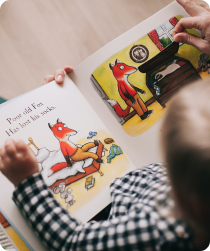
Developmental Therapies
The Cortica Care Model
Developmental Therapies address specific areas of need and strengths in a child's development during early years of life. Developmental therapies is an umbrella term for a set of therapies that focus on improving cognitive, social, motor, communication, and functional skills.
Learn more about:

What are Developmental Therapies?
At Cortica, Developmental Therapies address specific areas of need and strengths in a child’s development during the early years of life. Developmental Therapies is an umbrella term for a set of therapies that focus on improving cognitive, social, sensory, motor, communication, and functional skills in children with autism spectrum disorder (ASD).
Cortica offers the following Developmental Therapies at our centers and via telehealth:
Occupational Therapy
Speech-Language Therapy
Music Therapy
Physical Therapy

What is Occupational Therapy?
Occupational therapy uses play techniques to build a child's foundation in sensory processing and integration, self-care, fine motor development, self-regulation, social-emotional development, and play skills.
At Cortica, occupational therapy aims to improve everyday skills, which allow individuals with neurodevelopmental differences to become more independent and participate in desired activities.

What is the goal of Occupational Therapy?
The goals of occupational therapy vary based on each child’s unique developmental needs. Some goals and benefits of occupational therapy can include:
Regulation and arousal
Motor planning (creating, planning/organizing and executing movement patterns for everyday activities)
Independent dressing and grooming
Eating and meal participation
Using the bathroom
Fine motor skills such as drawing, painting, writing, or using scissors
Occupational Therapist (OT)
Master's or Doctoral degree
Conducts evaluations and re-evaluations
Designs and supervises occupational therapy programs
Occupational Therapist Assistant (OTA)
Conducts occupational therapy sessions
Supervised by OT
What is Speech Therapy?
Speech-language therapy uses a variety of functional daily activities and play-based techniques to improve a child's ability to effectively express themselves, understand others, produce sounds clearly, use language socially, problem-solve, chew, and swallow.
Children with neurodevelopmental differences may often have difficulties with communication. At Cortica, early intervention speech-language therapy integrates the child's unique sensory and motor profile into relationship-based activities to improve a child's functional communication.

What is the goal of speech therapy for autism?
The goals of speech-language therapy vary based on each child's unique developmental needs. Some goals and benefits of speech-language therapy can include:
Speech sound production
Language comprehension
Expressive language through gestures, speech, and/or alternative communication
Speech fluency (stuttering)
Social pragmatic communication
Organizing, planning and problem-solving
Speech-Language Pathologist (SLP)
Master's or Doctoral degree
Conducts evaluations and re-evaluations
Designs and supervises speech-language therapy programs
Speech-Language Pathology Assistant (SLPA)
Conducts speech-language therapy sessions
Supervised by SLP
What is music therapy?
Neurologic music therapy applies the tools of music such as rhythm, pitch and instrument play to foster language, sensory integration, cognitive control, motor planning and execution. Research shows that individuals with autism and other neurodevelopmental diagnoses respond positively to music— often showing a heightened neurologic response and interest.
At Cortica, music therapy focuses on promoting well-being and developmental goals through the therapeutic relationship and music as a means of expression and engagement.

What is the goal of music therapy for autism?
The goals of music therapy vary based on each child's unique developmental needs. Some goals and benefits of music therapy can include:
Task attention
Body awareness and coordination
Emotion awareness and regulation
Speech and vocalization
Executive Function (organization, planning, decision making and flexibility)
Social connection and trust building
Music Therapist (MT)
Bachelor's or Master's degree
Conducts evaluations and re-evaluations
Designs and supervises music therapy programs
What is Physical Therapy?
Physical therapy uses activities and exercise to improve gross motor skills and large-scale movements of the arms, legs, and torso, to build strength, balance, coordination, functional mobility, and endurance.
Children with neurodevelopmental differences often have underdeveloped muscle definition or poor posture and balance. At Cortica, physical therapy aims to help children build muscle control and strength so he or she can navigate their environment safely and play more easily with their peers.

What is the goal of physical therapy of autism?
The goals of physical therapy vary based on each child's unique developmental needs. Some goals and benefits of physical therapy can include:
Increased balance and motor coordination
Increased hand-eye coordination
Improved posture and strength
Functional mobility (walking and running)
Body safety and awareness
Physical Therapist (PT)
Master's or Doctoral degree
Conducts evaluations and re-evaluations
Designs and supervises physical therapy programs
Physical Therapist Assistant (PTA)
Conducts physical therapy sessions
Supervised by PT
Developmental Therapies at Cortica
Every child is unique, and we, at Cortica, believe your child’s therapy program should be just as extraordinary as they are. As our services provide a unique treatment and plan based on developmental therapies for your child, each therapy session is its own unique developmental path, to higher and higher levels of ability across all domains of learning. You should talk with your child’s provider to determine the right services that are right for your child.

Developmental therapies can be delivered in different ways depending on your child’s needs and goals:
One-to-One: Therapy provided by one therapist to one child.
Co-Treatment: Sessions provided by two therapists of different therapy types to one child.
Group Sessions: Sessions provided by one or more therapists to multiple children.
Parent Coaching: An interactive process between clinician and caregiver that involves observation, reflection, and action to directly promote the caregiver’s ability to support their child’s participation in family and community activities.

FAQs
Which developmental therapies are right for my child?
During your initial appointment, one of our medical providers will recommend any combination of the above developmental therapies based on your child's unique developmental goals. After this recommendation is made, our scheduling team will reach out to you to obtain your availability and schedule the initial evaluation appointment. Learn more about the roadmap to developmental therapies below.
If you are interested in getting started with any of the above therapies that were not recommended by your Cortica physician, please contact us at scheduling@corticacare.com or call your local center. To learn more about our services and therapies, please visit Cortica's Services and Therapies page.
Will my insurance cover Autism Therapy?
At Cortica, we work with a wide range of health insurance plans. We can provide you with a benefits check and cost estimate before beginning services with Cortica. Please reach out to us for information about your specific insurance coverage.